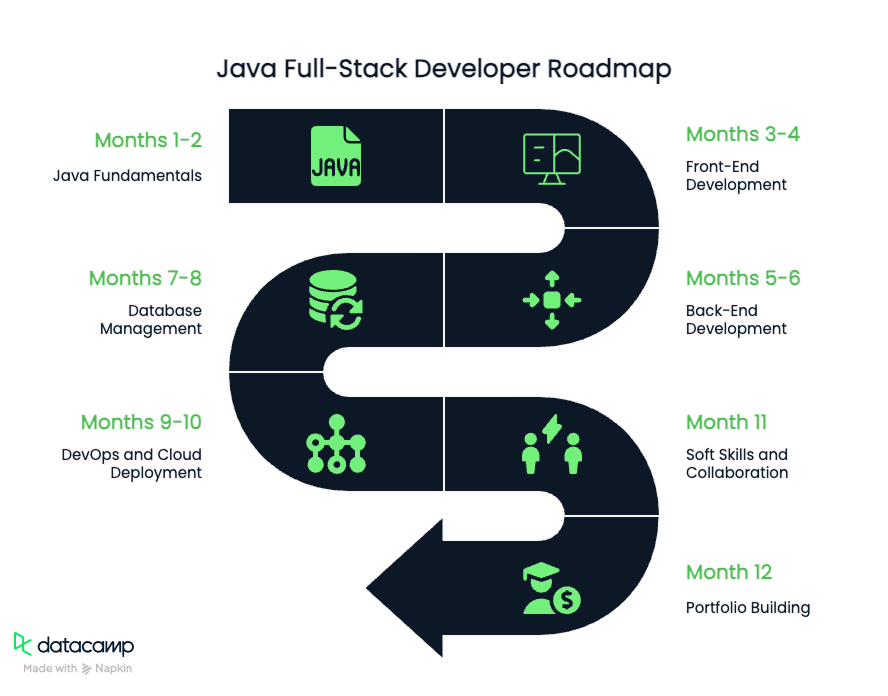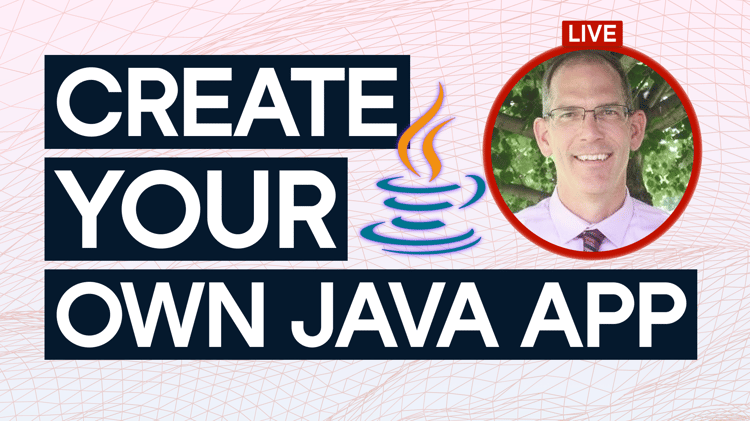Course
The demand for developers who can master both front-end and back-end technologies is at an all-time high. The Bureau of Labor Statistics predicts a 17% job growth between 2023 and 2033 for software developers, quality assurance analysts, and testers. As a Java full-stack developer, you’re expected to build engaging user interfaces and scalable, high-performance server-side systems, often wearing both hats within a single project. But with so many languages, frameworks, and best practices to master, the journey can feel daunting.
A clear, structured Java full-stack developer roadmap is essential to keep you on track, build confidence, and grow your expertise step by step. In this guide, I’ll walk you through a 12-month learning path that takes you from Java fundamentals to portfolio-ready projects and cloud deployment. Whether you’re starting from scratch or formalizing your skills, this roadmap is designed to help you progress efficiently and emerge as a job-ready Java full-stack developer.
If you’re looking to get started on your journey with some hands-on exercises, I recommend our Introduction to Java course.
TL;DR: 12-Month Java full-stack Developer Roadmap
- Months 1–2: Learn core Java and object-oriented programming concepts
- Months 3–4: Build front-end skills: HTML, CSS, JavaScript, and a modern framework (React or Angular)
- Months 5–6: Dive into back-end Java with the Spring ecosystem and RESTful APIs
- Months 7–8: Master database management (SQL and NoSQL) and optimization techniques
- Months 9–10: Embrace DevOps and cloud deployment (Jenkins, Docker, Kubernetes, AWS/Azure/GCP)
- Month 11: Strengthen soft skills, collaboration, and agile methodologies
- Month 12: Build a professional portfolio and complete capstone projects

Months 1–2: Core Java Fundamentals
To build robust, production-ready applications, you must first develop a strong foundation in Java. These first two months are dedicated to understanding both the “why” and “how” of Java programming.
Object-oriented programming principles
Java’s OOP principles, such as encapsulation, inheritance, polymorphism, and abstraction, are the backbone of all modern Java applications:
- Encapsulation keeps data secure and classes self-contained.
- Inheritance promotes code reuse and logical hierarchies.
- Polymorphism enables flexible and extensible code via shared interfaces.
- Abstraction hides complexity, focusing on essential behaviors.
By mastering these pillars, you’ll write code that’s modular, maintainable, and scalable—qualities prized in professional environments.
Advanced Java features
Once you’re comfortable with OOP, it’s time to explore Java’s powerful language features:
- Multithreading and concurrency: Learn to run tasks in parallel for responsive, efficient apps—an essential skill for modern development.
- Lambda expressions: Write concise functions and transform data with less code, making you more productive and your code more readable.
- Generics: Ensure type safety and reduce bugs by catching errors during compilation, not at runtime.
Just as important is your development environment. Become proficient with tools like Eclipse or IntelliJ IDEA for efficient coding, debugging, and integrated version control. Ensure you can install and configure the Java Development Kit (JDK) and Java Runtime Environment (JRE) smoothly.
It’s also important to start getting familiar with using Git and GitHub. Initialize repositories for your Java exercises, practice regular commits, and become comfortable with basic commands (commit, push, pull).
Top resources for months 1–2
- Introduction to Java: Start learning Java’s syntax and data structures.
- Java Fundamentals skill track: Learn the fundamentals of Java and start building real-world applications with one of the most widely used programming languages in the world.
- Introduction to Object-Oriented Programming in Java: Strengthen your OOP skills within Java’s context.
- OOP in Java: Classes, Objects, Encapsulation, Inheritance and Abstraction: Learn Object-Oriented Programming in Java with practical examples.
- Git Fundamentals: Learn version control with Git from basics to advanced workflows. Track changes, manage repositories, and collaborate efficiently.
- Git Push and Pull Tutorial: Learn how to perform Git PUSH and PULL requests through GitHub Desktop and the Command-Line.
Months 3–4: Front-End Development Technologies
With your Java foundations in place, the next step is to create engaging, responsive user experiences. This phase covers the essential front-end tools and techniques every full-stack developer needs.
Before jumping into frameworks, it’s critical to understand the core web building blocks:
HTML, CSS, and JavaScript
These three languages form the foundation of all web interfaces:
- HTML structures your content and lays out page elements.
- CSS controls layout, colors, and fonts. Get comfortable with Flexbox and CSS Grid for responsive, modern designs.
- JavaScript brings interactivity—handling events, manipulating the DOM, and updating content in real time.
Hands-on projects—like creating a personal landing page or interactive form—will solidify your understanding and provide immediate, visible results.
Modern frameworks
As web applications grow more complex, frameworks like React and Angular become essential:
- React: A popular library built around reusable components and declarative UI development. Its virtual DOM optimizes updates, making apps snappier.
- Angular: A comprehensive framework known for robust data binding, dependency injection, and a structured approach to large-scale projects.
Mastering at least one modern framework will make you more marketable and effective in real-world teams.
Make sure to host your front-end projects on GitHub, practice branching for new features, and learn to resolve basic merge conflicts.
TypeScript and accessibility
- TypeScript enhances JavaScript with static typing, catching errors early and improving code maintainability—an industry standard for large projects.
- Accessibility (a11y): Incorporate accessibility from the start. Use semantic HTML, ARIA roles, and keyboard navigation to ensure your applications serve all users.
Top resources for months 3–4
- 14 Java Projects For All Levels: Beginner, Intermediate, and Advanced: Find project ideas to practice both front and full-stack skills.
- A Data Science Roadmap for 2025: See how front-end tech connects with data-driven applications.
- GitHub Foundations: Prepare for the GitHub Foundations Certification by learning the fundamentals of Git and GitHub: version control, collaboration, and branching.
- Intermediate Java Course: Take your Java skills to the next level by mastering methods, control flow, and loops—three essential building blocks of real-world programming.
Months 5–6: Back-End Development With Java Frameworks
Once you’re comfortable with the front end, it’s time to build powerful back-end systems that handle data, logic, and application security.
The Java ecosystem is renowned for its enterprise-grade frameworks and scalability. This period focuses on the Spring ecosystem and building robust APIs.
Spring ecosystem
- Spring Framework: The core of modern Java back-end development, providing modularity and inversion of control.
- Spring Boot: Streamlines application setup and configuration, allowing you to build and deploy services quickly.
- Spring Security: Simplifies the integration of authentication and authorization.
- Spring MVC: Separates presentation, logic, and data, making your app easier to test and maintain.
- Spring Cloud: Supports microservices, distributed systems, and service discovery.
- JUnit: Write and run unit tests for your Spring applications using JUnit. Get comfortable testing controllers, services, and repositories to ensure code correctness and reliability
Database integration and ORM
No application is complete without data management. You’ll need to:
- Work with relational databases (MySQL, PostgreSQL) for structured, transactional data.
- Understand NoSQL databases (MongoDB) for flexible, unstructured, or rapidly changing data.
- Use Hibernate for object-relational mapping (ORM), bridging Java objects and database tables efficiently.
RESTful APIs and web services
APIs are how your front and back ends communicate:
- Learn HTTP methods (GET, POST, PUT, DELETE), status codes, and best practices in API design.
- Use Spring REST to create clean, scalable APIs that serve front-end clients or other services.
Top resources for months 5–6
- Creating Your First App with Java: In this code-along you'll learn how to create a simple Java calculator application.
- MySQL Tutorial: Discover what MySQL is and how to get started in one of the most popular database management systems.
- Creating PostgreSQL Databases Course: Learn to create PostgreSQL databases with and explore the structure, data types, and normalization of databases using PostgreSQL.
- Introduction to NoSQL course: Explore the basics of NoSQL databases, and how they're used in a modern data architecture.
- MongoDB Tutorial: Learn how to connect and analyze MongoDB databases in Python.
- Java Certifications in 2025: Which One is Right for You?: Explore certifications focused on back-end and Spring expertise.
Months 7–8: Mastering Database Management and Optimization
Databases are at the heart of nearly every application. This phase goes beyond basic CRUD operations, focusing on designing, scaling, and optimizing your data layer for performance and reliability.
A well-designed database ensures your applications can grow and handle real-world demands.
Relational and NoSQL databases
Understand when to use each type:
- Relational databases (SQL): Ideal for structured data, transactional integrity, and complex queries. Use normalization to reduce redundancy and maintain data integrity.
- NoSQL databases: Suited for unstructured or fast-growing data, offering horizontal scalability and flexible schema designs.
Consider real-world scenarios, for example, an e-commerce app may need a relational database for orders and a NoSQL database for product reviews.
Query optimization and indexing
Efficient queries are critical for scalable applications:
- Indexing: Speeds up searches; know how to implement and maintain indexes for performance.
- Query optimization: Understand how to write efficient SQL and use the database’s query planner.
- Sharding and replication: Ensure high availability and fault tolerance for production environments.
Learning to analyze slow queries and optimize schemas will pay dividends as your applications scale.
Top resources for Months 7–8
- Associate Data Engineer in SQL: Sharpen your SQL and data modeling skills.
- Comprehensive NoSQL Tutorial Using MongoDB: Cover the fundamentals of NoSQL databases, and different types of NoSQL databases with examples available in the industry.
Months 9–10: Embracing DevOps and Cloud-Native Deployment
Building great applications is only part of the journey—you also need to deliver them reliably to users. DevOps and cloud skills are now must-haves for modern developers.
This stage focuses on automating, deploying, and managing your applications efficiently.
Continuous integration and deployment
- Jenkins: Automate your build, test, and deployment pipelines for faster, more reliable releases. Integrate running unit tests in your Jenkins CI pipeline to automate code validation.
- Docker: Package apps and their dependencies into containers, ensuring consistency across environments.
- Kubernetes: Orchestrate containers at scale, manage deployments, and enable self-healing systems.
Deepening your DevOps skills allows you to ship features faster and with fewer bugs.
Cloud platforms
- AWS, Azure, Google Cloud: Learn to deploy Java applications, use managed services (like cloud databases), and scale your infrastructure as your user base grows.
- Serverless architectures: Explore simplifying deployments for certain workloads—great for microservices and rapid prototyping.
Understanding these tools makes you an asset to any team tackling large-scale or distributed systems.
Top resources for months 9–10
- Introdution to Docker course: Explore the basics of Docker, including Docker engine, terminology, and commands using the Docker Command Line Interface (CLI).
- Introduction to Kubernetes course: Learn the fundamentals of Kubernetes and deploy and orchestrate containers using Manifests and kubectl instructions.
- Developing AI Applications: Learn how cloud deployment relates to modern, data-driven projects.
- Azure DevOps Tutorial: Discover how to set up an Azure DevOps environment, use Azure Repos for version control, create and manage CI/CD pipelines, and more.
- AWS Concepts Course: Learn the basics of Amazon Web Services (AWS), one of the leading cloud platforms businesses use worldwide.
Month 11: Soft Skills and Collaborative Practices
Being a successful developer requires more than technical prowess. Effective collaboration, communication, and adaptability are essential in every professional environment.
In this stage, focus on becoming a valuable teammate and agile contributor.
Agile methodology and team practices
Most software teams rely on agile frameworks like Scrum and Kanban:
- Learn about or participate in sprint planning, daily standups, and retrospectives to drive iterative improvement.
- Explore the use of Kanban boards to visualize tasks, track progress, and identify bottlenecks.
Version control and collaboration
- Continue developing collaboration skills, particularly focusing on advanced Git workflows like pull requests, peer reviews, and merging.
- Collaborate on platforms like GitHub, practicing pull requests and code reviews to improve quality and share knowledge.
Communication and problem-solving
- Communicate clearly and respectfully with technical and non-technical colleagues.
- Develop strong debugging skills: analyzing logs, reproducing issues, and isolating bugs systematically.
These abilities set you apart as a reliable, adaptable contributor in any organization.
Top resources for month 11
- Top Learning and Development Conferences in 2025: Find opportunities to grow your communication and teamwork skills.
- Git Merge Tutorial: Learn how to use git merge to combine branches, resolve conflicts, and follow best practices.
- 10 Business Skills Every Data Team Needs: In this webinar, discover how storytelling, empathy, and consulting skills can transform technical metrics into impactful business results and accelerate your data career.
Month 12: Portfolio Building and Capstone Projects
To land your first full-stack role, you need more than technical knowledge; you need to show your skills in action. A professional portfolio and capstone projects are your chance to demonstrate your full-stack capabilities to employers and peers.
Capstone projects
Select projects that highlight both your breadth and depth:
- E-commerce platform: Integrate shopping carts, payment processing, and user authentication. Demonstrate end-to-end knowledge, from database modeling to front-end checkout flows.
- Blogging system: Support user-generated content, comments, and real-time updates—build features like markdown support or notifications.
- Task management tool: Implement live collaboration with WebSockets, complex state management, and secure user roles.
Every project should use the full stack, from database and API design to front-end UI/UX, to secure authentication and deployment.
Building your professional portfolio
- Create a personal website highlighting your best work, background, and technical interests.
- Share your code on GitHub; well-documented repositories with clear READMEs stand out to hiring managers.
- Maintain a strong LinkedIn presence and engage with the developer community by writing technical blog posts or contributing to open-source projects.
A polished portfolio is your gateway to job interviews, freelance opportunities, and professional networking.
Top resources for month 12
- 14 Java Projects For All Levels: Beginner, Intermediate, and Advanced: Find inspiration for your capstone and portfolio projects.
- 56 Java Interview Questions And Answers For All Levels: Prepare to effectively discuss your projects during interviews.
Conclusion
The journey to becoming a Java full-stack developer is both challenging and rewarding. By following a focused, 12-month roadmap, moving from Java fundamentals to advanced deployment and portfolio projects, you’ll build the skills needed to create, deploy, and maintain robust applications from end to end.
Remember: consistent, hands-on practice is key. Tackle new frameworks, seek feedback from peers, and stay engaged with the developer community. Keep your portfolio up to date, and remain open to lifelong learning. As technology continues to evolve, your commitment to growth will keep you ahead in the field.
Ready to get started on your journey? Dive into the Java Fundamentals skill track today and take your first step toward a rewarding career as a Java full-stack developer.
Java Full-Stack Developer Roadmap FAQs
How do I balance front-end and back-end development?
Set clear learning objectives and alternate focus between front-end and back-end skills. Integrate both in small projects to reinforce your understanding. Use modern development tools to streamline your workflow and avoid context switching fatigue.
What challenges do Java full-stack developers commonly face?
You’ll often encounter rapidly evolving frameworks, complex integrations, and the need to ensure seamless communication between front-end and back-end systems. Performance tuning and cross-stack debugging can also be challenging, especially in large or distributed projects.
How important is it to stay up to date with Java frameworks and technologies?
Crucial. The Java ecosystem is constantly evolving, with new frameworks, tools, and best practices emerging regularly. Keeping your skills current ensures your applications are secure, efficient, and maintainable—and keeps you competitive in the job market.
What real-world projects help build practical experience?
Develop a personal portfolio website, an e-commerce platform, or a RESTful API for a mobile app. Participate in open-source projects or hackathons to practice collaboration and problem-solving under real constraints. These experiences translate directly to skills employers value.

A senior editor in the AI and edtech space. Committed to exploring data and AI trends.

